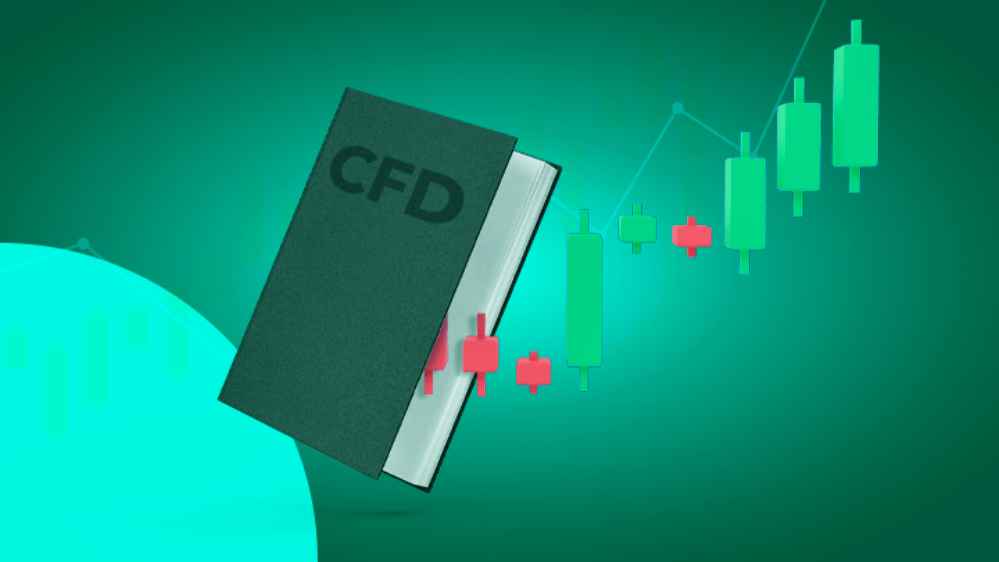
CFDs, or Contracts for Difference, are financial derivatives that allow traders to speculate on the price movements of various financial instruments without actually owning the underlying assets. CFDs are popular in trading because they provide a way for investors to profit from both rising and falling markets.
When a trader decides to enter into a CFD, they choose an underlying asset and decide whether they expect its price to rise (go long) or fall (go short). If the price moves in the direction they predicted, the trader makes a profit; if it moves against them, they incur a loss.
One of the key features of CFDs is leverage, which allows traders to control a larger position size with a relatively small amount of capital. While leverage magnifies potential profits, it also increases the risk of significant losses. Traders should exercise caution and fully understand the implications of leverage before engaging in CFD trading.
Here's how CFD trading works:
-
Agreement between Buyer and Seller: In a CFD trade, there are two parties involved—the buyer and the seller. The buyer agrees to pay the seller the difference between the current value of an asset and its value at the contract time.
-
No Ownership of the Underlying Asset: Unlike traditional trading where you physically own the asset, with CFDs, you do not own the underlying asset. Instead, you are speculating on the price movement of the asset.
-
Leverage: CFDs are traded on margin, which means you only need to deposit a fraction of the total trade value. This allows traders to leverage their positions, potentially amplifying both gains and losses.
-
Long and Short Positions: Traders can take either a long position (expecting the price to rise) or a short position (expecting the price to fall). This flexibility is one of the key advantages of CFD trading.
-
Wide Range of Markets: CFDs can be based on various underlying assets, including stocks, indices, commodities, currencies, and bonds. This provides traders with access to a diverse range of markets.
-
No Expiry Date: Unlike options or futures contracts, CFDs generally do not have an expiry date. Traders can hold their positions for as long as they want, provided they have enough margin in their account.
-
Hedging: CFDs can be used for hedging purposes, allowing traders to offset potential losses in one investment with gains in another.
CFDs vs. Forex: Unraveling the Nuances
While both CFDs and Forex involve financial speculation, they are fundamentally different. Forex revolves around fiat currencies, whereas CFDs are derivatives contingent on the price movements of various assets. Check this report for a detailed overview: market sentiment Forex.
Is CFD Trading a Prudent Choice?
The allure of lower entry costs in CFD trading is tempered by significant risks, as losses are amplified. Managing these risks becomes paramount, emphasizing the need for robust risk management strategies.
CFDs vs. Traditional Investments: Delving into Complexity
Comparing CFDs with traditional investments reveals multifaceted intricacies. The potential for higher risks in CFDs necessitates a nuanced understanding for traders contemplating this financial avenue.
CFDs vs. Forex: Exploring Diversity in Trading
Beyond the confines of currency pairs, CFDs offer a broader spectrum of assets for trading. Unlike Forex, which predominantly deals with major currency pairs, CFDs open the door to a diverse array of financial instruments. Even the best forex trader in the world can not afford such a high leverage.
Advantages of CFD Trading
-
Diverse Asset Classes: CFDs offer access to a wide range of financial instruments, including stocks, indices, commodities, and currencies, allowing traders to diversify their portfolios.
-
Leverage: As mentioned earlier, CFDs enable traders to amplify their market exposure with a smaller upfront investment. This can potentially lead to higher returns, but it comes with increased risk.
-
No Ownership of the Underlying Asset: Traders don't need to physically own the underlying asset to trade CFDs, making it a convenient way to speculate on price movements without the complexities of ownership.
-
Short Selling Opportunities: CFDs allow traders to profit from falling prices by going short, providing opportunities to benefit from both rising and falling markets.
Risks Associated with CFD Trading
-
Leverage Risk: The use of leverage amplifies both potential gains and losses. Traders can lose more than their initial investment, leading to significant financial consequences.
-
Market Risk: CFDs are highly sensitive to market movements, and sudden price fluctuations can result in substantial losses.
-
Counterparty Risk: CFDs are traded over-the-counter (OTC), and traders are exposed to the financial stability of the CFD provider. If the provider faces financial difficulties, it may impact the trader's ability to withdraw funds.
-
Complexity and Understanding Risk: CFD trading involves a complex set of financial instruments, and traders need a thorough understanding of the market, the assets they are trading, and the associated risks.
Weekend trading on BTC/USD, ETH/USD, LTC/USD and an announcement of Evolution towards JForex4 platform: https://t.co/z9lY53NlOB pic.twitter.com/rHeHlCgo11
— Dukascopy Bank SA (@DukascopyBankSA) September 11, 2020
Are CFDs a Gamble or an Investment Strategy?
While CFDs share similarities with spread betting, they are considered financial instruments, not gambling. The key distinction lies in their treatment under tax regulations—spread betting is tax-free, whereas CFDs are not.
Why Do Many CFD Traders Face Losses?
The absence of robust risk management strategies is a leading cause of CFD trading failures. Opening trades without protective measures like take-profit and stop-loss orders exposes traders to significant losses.
Success Rates in CFD Trading: Navigating the Statistics
Day trading within the realm of CFDs holds profit potential. However, historical data, as per the European Securities Markets Authority (ESMA), suggests a substantial failure rate, ranging between 74% and 89% for new CFD traders.
Contract for Differences (CFD) trading has become a popular method for speculating on financial markets, offering flexibility and accessibility to a diverse range of assets. However, the potential for both significant gains and losses makes it crucial for traders to approach CFD trading with caution, fully understanding the risks involved and implementing risk management strategies. As with any form of financial trading, education and diligence are key to navigating the complexities of CFDs successfully.

Written by Michael Zippo
Michael Zippo, passionate Webmaster and Publisher, stands out for his versatility in online dissemination. Through his blog, he explores topics ranging from celebrity net worth to business dynamics, the economy, and developments in IT and programming. His professional presence on LinkedIn - https://www.linkedin.com/in/michael-zippo-9136441b1/ - is a reflection of his dedication to the industry, while managing platforms such as EmergeSocial.NET and theworldtimes.org highlights his expertise in creating informative and timely content. Involved in significant projects such as python.engineering, Michael offers a unique experience in the digital world, inviting the public to explore the many facets online with him.
